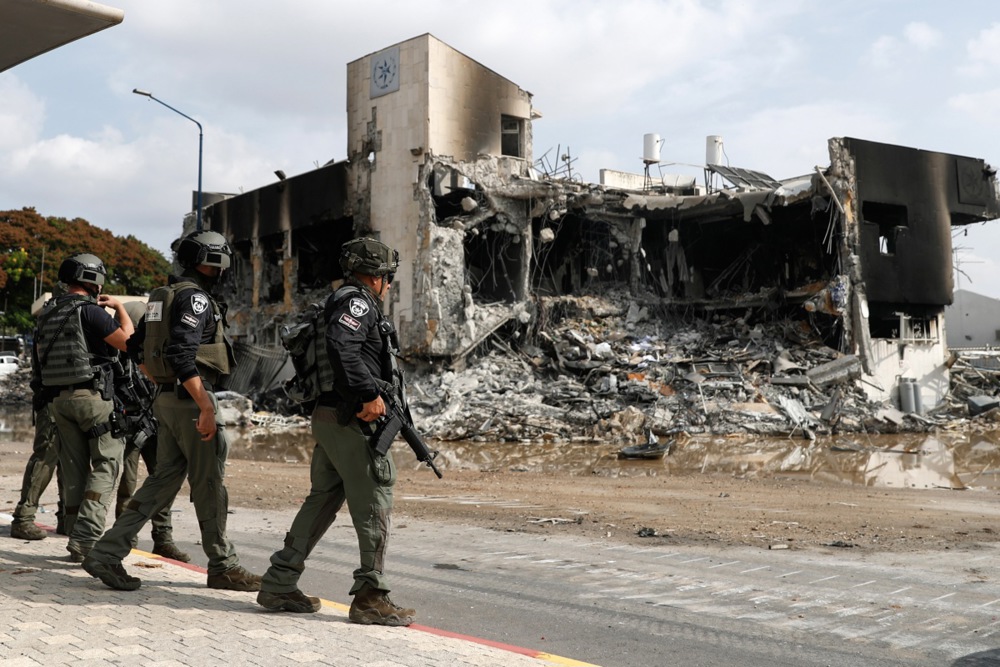On Monday afternoon, the US Secretary of Defense said America and its allies including the UK, Canada, France and others agreed to create a naval task force to counter attacks on ships in the region.
“This is an international challenge that demands collective action,” Secretary of Defense Lloyd J. Austin said in a statement.
European natural gas prices surged by as much as 13 per cent amid the most concrete sign yet of disruption to energy flows since the start of the war in Gaza. Brent oil futures traded higher on Tuesday after rising as much as 3.9 per cent in the previous session.
From BP Plc to A.P. Moller-Maersk A/S, companies that transport consumer goods, commodities like coal and corn, and energy supplies face longer journeys. While there’s some slack in global supply lines to absorb the recent capacity strains, the sudden closure of the Suez Canal in 2021 showed how fragile networks are when major links break down.
US officials are scrambling to come up with a response as global trade comes under threat. The defense secretary will convene fellow ministers Tuesday to discuss next steps to deal with the Yemen-based militants. But it’s not straightforward, and Gulf allies in the region don’t agree on the correct approach.
John Kirby, spokesman for the National Security Council, told reporters that the talks will be about reinforcing “an existing maritime force under the Fifth Fleet in Bahrain.” He said “what we’re trying to do is strengthen, bolster it and operationalize it in ways that perhaps it hadn’t been operationalised prior to these Houthi attacks.”
Meanwhile, the unrest persisted. Chemical and oil tanker Swan Atlantic was attacked by a drone and an anti-ship ballistic missile from Houthi-controlled Yemen on December 18, US Central Command wrote on X. The vessel was hit and requested assistance from a nearby warship. Separately, bulk cargo ship M/V Clara was targeted the same day, but no damage was reported, according to the command.
The incidents are threatening a trade corridor through which about 12 per cent of seaborne commerce normally passes. They’re happening at a time when the world’s other vital ocean-to-ocean waterway — the Panama Canal — is being severely restricted by drought. They also come as central banks remain wary about inflation risks.
“Rising uncertainty in the Suez channel combined with the global economy rebounding because of easier financial conditions could put upward pressure on goods inflation over the coming months,” Apollo Global Management chief economist Torsten Slok said.
Fifty-six merchant ships entered or left the Red Sea on Saturday and Sunday, according to data compiled by Bloomberg. That’s down by 35 per cent from the start of the month.
BP said it would “keep this precautionary pause under ongoing review, subject to circumstances as they evolve in the region.” None of its ships — those it owns or those it hires — will pass through the Red Sea. Its statement was followed hours later by Norway’s Equinor ASA, which said it will reroute ships. Mosaic Co., one of the world’s top makers of phosphate and potash fertiliser, diverted one of its ships traveling from Saudi Arabia to New Orleans.
Those moves came as a fuel tanker was struck by an “unidentified object” on Monday, according to its owner. Attacks are now occurring almost daily.
The Iran-backed Houthis say they’re targeting any vessel with a connection to Israel as a response to the country’s war with Hamas, which has been designated by the US and European Union as a terrorist organisation. Those links have appeared increasingly tenuous in the past week or so, and the owner of the tanker attacked on Monday, the Swan Atlantic, said there was no connection.
“There is no Israeli link in the ownership (Norwegian), technical management (Singapore) of the vessel nor in any parts of the logistical chain for the cargo transported,” Rieber & Son said in a statement on its website.
The tanker was transporting biofuel feedstock to Reunion from mainland France when it came under attack. There were no injuries and the vessel is sailing using its “own machinery with all systems operational,” Rieber & Son said.
The London-based Joint War Committee, which advises Lloyd’s marine-insurance underwriters on risk, on Monday expanded the portion of the Red Sea that it considers to be part of the world’s riskiest waters. That means the amount of time that ships need cover against war risks will increase. The cost of such cover has surged almost 10-fold since the attacks first began.
Three container ships came under attack in the space of about a day late last week, prompting owners including MSC Mediterranean Shipping Co. SA, A.P. Moller-Maersk, CMA CGM — the top three — to announce plans to stay away. On Monday, German container carrier Hapag-Lloyd AG said it was sending several ships around southern Africa instead of going through Suez. That will continue until the canal and the Red Sea are safe again, a spokesman said.
There are 46 container vessels that have diverted around the southern tip of Africa rather than using the Red Sea and a further 78 awaiting instructions, Ryan Petersen, the founder of logistics firm Flexport said on X.
Already rates to ship goods in containers from Asia to the Mediterranean are rising. According to Freightos.com, a booking and payments platform for international freight, the rate for that route through Suez as of Sunday was $2,414 for a 40-foot container, up 62% since the end of November.
The Suez Canal has also emerged as a major route for the global LNG trade over the past two years, bolstered by Europe’s appetite for the super-chilled fuel as the main replacement of piped Russian natural gas. Its importance has amplified this year as Asia-bound cargoes take longer routes amid the congestion on the Panama Canal. LNG vessels have also been rerouting, taking the longer and more expensive route via the Cape of Good Hope.
“The situation does mean an increase to shipping costs and some short-term delivery delays,” said Henning Gloystein, a director at researcher Eurasia Group. “All these costs will be directly passed on to consumers.”





